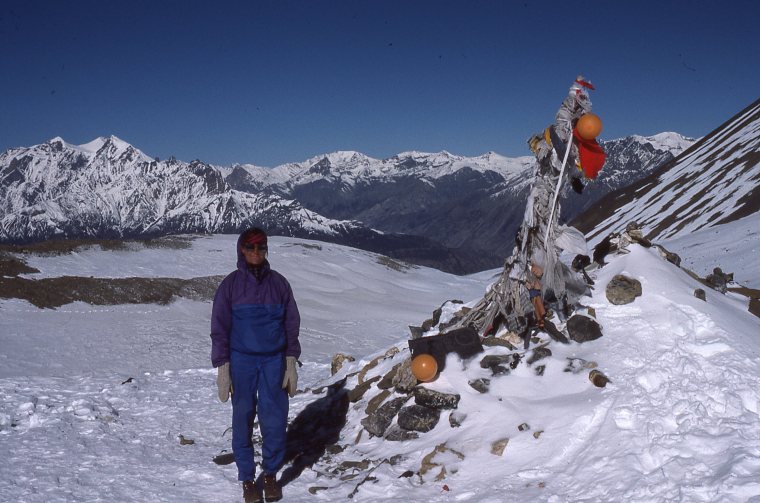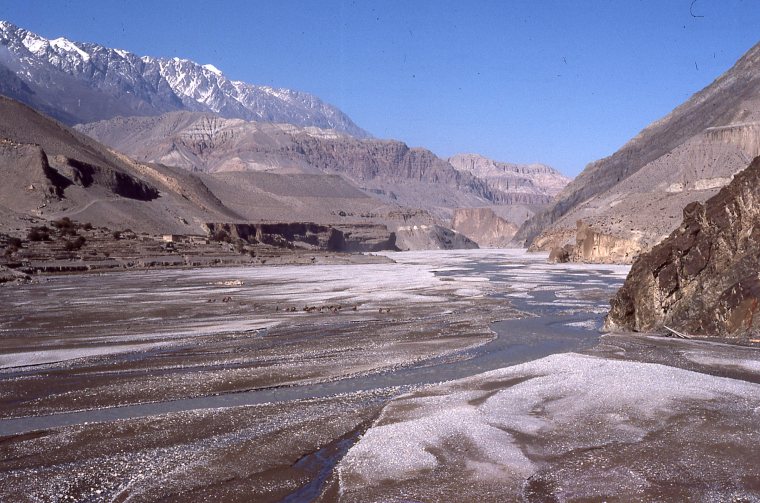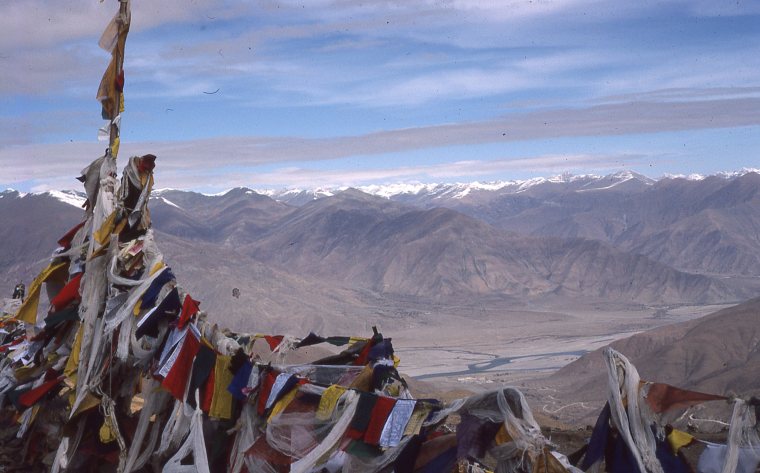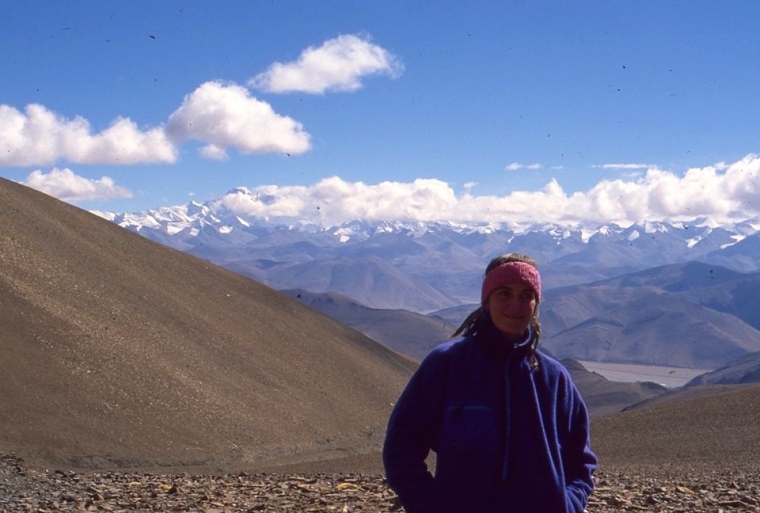Of all the travels that I have been blessed to experience in my life, the traveling I did in Tibet in the 80’s was the most utterly magical and life altering experience I have had.

I suppose the story of my travels to Tibet began in May 1984, as that is the summer I moved from Toronto to Banff. I had already become obsessed with Tibet after seeing a coffee table picture book at my boyfriends house when I was 19 years old. I had never been west of Toronto, and yet felt totally compelled to go to the Himalayas. It seemed wise at first to start with immersing myself in the mountains of Canada. So, in May I did an Outward Bound month long “major challenge course” in Keremeos, BC, and then started living in Banff.
That same year in September of ’84, Tibet became open to individual travelers. As Mark A. Cohen wrote in the Washington Post on June 6, 1985 :
“This year marks the 20th anniversary of Tibet’s incorporation into the People’s Republic of China, and finally the roof of the world is accessible to individual travel. Until last fall — when Tibet was officially opened to individual tourism — you had to take a rushed and expensive tour to reach this outermost region of China. But today, independent travelers can spend as little as $10 a day and take as much time as they want to explore this land of exotic customs and rugged scenery.”
It didn’t take long for word to spread amongst the adventuresome folks in Banff that travel in Tibet was possible, and by the following fall of 1985, I was determined to go. I had saved $3500 from my job with Parks Canada cooking for trail crew in the back country of Banff National Park. I spent half of that on a flight to Kathmandu, which I booked for the day after my job finished. After our last helicopter flight back to Banff, I did my laundry, packed and then headed to the Himalayas for 3 months of diving into the unknown.

And it was truly the unknown! There were no guide books at this time for Tibet. The first Lonely Planet guidebook had not been published as the writers Michael Buckley and Robert Strauss had just themselves started traveling there mid-’85.
And so I arrived in Kathmandu with great hopes, yet, didn’t find out until I was there that it was not possible to access Tibet from Nepal, unless you already had a Chinese Visa – and that year you could not get a Chinese Visa in Kathmandu. Instead, you had to get one in Hong Kong or Delhi, or elsewhere. Because of this most people were traveling overland from Chengdu, China to Lhasa, or traveling the long journey from Golmud, in the far north of Tibet, to Lhasa rather than from Kathmandu.

Regardless of not getting to Tibet, I had an incredible trip, and trekked for 2 months – in Langtang area, as well as spending a month doing the Annapurna circuit (photos above). I remember climbing the Thronla Pass on the north side of Annapurna and dropping into the Kali Gandaki basin (photo below). There was a sign saying “Restricted”. I knew if I travelled up this valley it would take me to the Mustang region and then Tibet, yet what you see below was the closest I got to Tibet on this trip…

When I got back to Banff I immediately set to saving money so I could go back to the Himalayas and find a way to get into Tibet. I worked a winter season with Canadian Mountain Holidays at a heli-skiing lodge in the Bugaboos and another summer with Parks Canada, and then I was ready.

So, in October of ’86, me and my boyfriend at the time, flew straight to Hong Kong, got our Chinese Visas and began the journey into Tibet.
We crossed the border from Hong Kong into China and took a train for 3 days to Chengdu, and a few days later got on a plane to Lhasa. We did consider going overland, however we heard horror stories of land slides and road blocks as trucks had to navigate the deep river valleys of the Yangtze, Mekong and Salween and we wanted to avoid any obstacles.
I remember waiting in the small, derelict Chengdu airport brimming with excitement that I was finally going to Lhasa, and all the sudden looked over and recognized Jeffrey Hopkins – renowned Bhuddhist Scholar whose book “The Tantric Distinction” I had bought the year before. It was an auspicious meeting! Aside from the group he was leading, I don’t recall seeing any other individual travelers at all.
And then we were flying over the Tibetan plateau! I remember looking down and seeing the huge mountain Namche Barwa in Eastern Tibet. I remember landing on an insubstantial runway, with barely a building in site. I remember thinking that nothing could have prepared us for the experience of arriving on the plateau. We were mesmerized by the thin crisp air, the deep blue sky, the rustic airport and gravel road that brought you to the Western Gate of the Potala.

We somehow managed to get transport into Lhasa, but as most of the tourism infrastructure was set up for tours, we were on our own in all sense of the word. We walked down the main street of Lhasa with our packs on our backs as though in another world. There was no commercialization of Tibet at the time. It was like a medieval city. There were throngs of nomads arriving on pilgrimage dressed in their yak skin chubas, the women with braided hair, many Tibetans wearing Mao suits and caps, herds of yaks and flocks of sheep in the roads.

You may be wondering why I am telling this story now. Well, after 30 years of wanting to return to Tibet, I finally did last summer. And I suppose I have been reminiscing. As I was preparing for my journey, I knew I had these slides from my trip in 1986, but didn’t pull them out. When I returned from my pilgrimage, I was so engrossed with just digesting it, I still didn’t look at my old slides. Anyways, the other day, I got a scanner and scanned them.

The most incredible thing is what I found. During the trip I made to Tibet in 1986, I only took 41 pictures! I was there for 5 weeks and only took 41 photos!! And not one of them had me in the photo! Oh, how times have changed! Traveling to Tibet was just the beginning of a seven month trip. From there we would go to Nepal for a couple months, then Thailand, and India. All in all I travelled from October ’86 to May ’87. I brought 6 rolls of 36 exposures – film for slides. I had a Pentax K1000 camera, and barely did it leave my pack.

Last summer, in Eastern Tibet I took 1260 photos! It’s hard to recall how different photography was back in the old days. One took a photo with no idea what it might look like or whether the exposure was right, and then had to wait till you were back home to develop and see the photos. That is, after you set up a slide projector and screen! Well, I am so happy with the photos I have, but so wish I had more.

To top this off, when I returned to Tibet two years later in 1988, I did not even have a camera, and didn’t take one photo! I was traveling with a friend, and at the very start of our trip we had been drugged and robbed on a bus going from Ko Samet to Bangkok. They took all our money, my camera, but left us our passports. We were able to continue our trip undaunted and got our travelers cheques back, flew to Kathmandu, and soon after flew from there to Tibet for a few weeks. My friend thankfully did take some photos, and there is one photo of me on the plateau.

It was an absolutely magical, mesmerizing trip.
But back to 1986. We were so blessed to go to Tibet when there was so much freedom to explore. There were restricted areas, but with perseverance you could find a way to get there, often in the back of a truck. After a week exploring Lhasa area, we travelled to what was a restricted area south east of Lhasa – the Yarlung Valley, Tsedang and Samye Monastery. We spent a whole day the Yumbulakang palace, which according to legend is the first building built in Tibet. We did not see one other person there all day long, except this woman and child and the caretaker who was an old man with one long brown tooth.

I wrote in my journal:
“The sky was so blue as the palace framed itself against the sickle moon. Prayer flags and clove wine and a little old man who danced through the woodwork. Hopping from side to side and smiling his toothless smile, save the beauty: the big long brown tooth that made up for all the rest. But the Yumbulakang itself – high up on the rocks looking so far from east to west through fields of yak and sheep, fabulous Tibetan homes, and a river like sapphire coloring the vegetation around it.”

“The expanse of the valleys and ravines seem wider than the mind can fathom. So flat and big, and then so deep and broken, discovering camouflaged monasteries and pilgrim paths as forlorn and barren as all the rest. And one sits for ages just staring and following over and over again the line of the deep blue sky against the brown corrugated mountains. Then to the snow peaks. Then to the fields. Then to the palace that has been there for hundreds of years. The kings. The monks. The lifetimes…”

From there we crossed the Yarlung Tsangpo River to go to Samye Monastery and then had a plan to do a three day hike on a pilgrim trail which went north to Ganden Monastery. We camped in the trees above, after traveling across the river with some pilgrims.

I remember being so entranced with their yak skin chubas, fur hats, braided hair, and warm disposition. We did not see one other westerner the whole time there.

The next day we walked through the sand dunes seen at the opposite shore to where Samye sits – the bottom of the first ridge on the left.

Samye is the oldest Monastery in Tibet, and had been almost completely destroyed during the Cultural Revolution. When we were there it was being rebuilt and only the first story was complete. This photo below was taken two years later when it was restored completely with it’s three storeys and gilded golden roof which you can see off in the distance.

After a few days at Samye Monastery, we embarked on our pilgrimage to Ganden Monastery. We had no maps. We were young and strong, and had our tent, gear and as much edible food as we could muster from the market in Lhasa. Food which I remember being unbelievably meager. We had dried yak cheese, yak jerky, canned goods and ridiculously hard, dry biscuits from the Chinese army called 481 Biscuits.

We had hiked from the bottom of this valley, and it was strenuous and exhausting. From the fields in the bottom left of the photo above, we hiked further up the valley towards a pass. All we knew from word of mouth is that we would hit a high plateau, and eventually we would find another monastery, a famous huge one – Ganden. We knew this – and also that Tibetans were telling us not to go. We were told there were bandits up there and that they would steal all your belonging and eat you!

Well, after two days of hiking, forging a terrifying river, eating cans of pork that were mostly sauce and no pork, battling the altitude, seeing the pass and being horrified by the distance, we turned around. We didn’t feel confident we had enough food, or that I could handle the altitude. When we returned to the high fields in the picture before the last one, we camped for the night.
In the morning we were woken by a group of pilgrims fascinated with us and our belongings. They poked through all we owned playing with zippers, laughing and gesturing to things. Then pointed up the hillside above saying, “Gompa? Gompa?”
We scanned the slope unsure of what they were talking about. Until we discerned a small temple perched high in the rocks. You can see it in the above picture a little bit below the ridge line.

And so we climbed the switch backs up to the temple. I only found out later that it is an incredibly important temple where Padmasambhava and Yeshe Tsogyal spent time.
On the Dharma Wheel website, it says: “It is here, when Yeshe Tsogyal was 16 years old, that Guru Rinpoche taught her the Tripitaka, the basics of Buddhism, and bestowed the first tantric empowerments along with the sacred commitments. Afterwards, Yeshe Tsogyal meditated here, assimilated the teachings, and achieved a high degree of understanding. The goddess Saraswasti appeared to her in a vision and graced her with complete retention of what ever she was taught.
Reflecting on her experiences at Yamalung, Yeshe Tsogyal said, “I received all the teachings as if the contents of one vessel were being transferred into another”. At the end of this period, Tsogyal returned to Samye and then journeyed to Zhoto Tidro which was to become her principal place of practice.
She returned to Yamalung several times and hides secret treasures.”

There was only one monk there on a three year, three month, three day retreat. There were two rooms – a shrine room on the left with a rock painting of Padmasambhava, also known as Guru Rinpoche, and living quarters on the right. The monk was practicing silence, and so hand gestured for us to sleep in the shrine room, and also graphically demonstrated to not have sex there!

I remember hearing him chant all night long and we stayed a couple days exploring the meditation caves and stupendous views down the valley.

From here, we returned to Lhasa, but of course had to go to Ganden to see the monastery and what was to be the end point of our pilgrim trek.

This photo that I took above shows the long winding road to Ganden Monastery. But, it’s hard to believe that I took no pictures of the monastery. It was heart wrenching to see the devastation of the Cultural Revolution, which you can see below is a photo taken by John Stratton from his book, “Tibet: Journey to a Still Land”. His book was written in 1997, and much more had been restored than when we were there in 1986. When we were there, I only remember the main temple and building to the right being there.

Here is another photo of Ganden below from the book “My Tibet” by Galen Rowell written in 1990. We sat all day on the terrace in front of the monastery on the left, which you can clearly see in the photo, with a group of monks.

We were showing them a stack of photos and postcards from our life in Banff, and as they were being passed around they all the sudden disappeared! We hung out for the longest time as various monks interrogated each other and showed their concern. Hours later a poor monk showed up and sheepishly returned the pictures.
The only photo I took other than the prayer flags on the ridge above of the monastery was of the freshly painted wall of the neighboring building.

Meanwhile, our journey was still full of such adventure. When back in Lhasa, we spent time at Sera Monastery, a bicycle ride from Lhasa.

Everyday brought fascination.

Beauty…

We wandered freely through Sera Monastery, and climbed the boulder field mountainside above the monastery. I wrote in my journal at the time:
“And that drum emanated my spirit. So deep and thorough it was pounding my soul. Looking around that dark room. So many figures, so many lifetimes. And I buzz through even more chambers, more rooms, more statues, more storeys, more drums, more cymbals, more bells and another moon. The same moon drifting through the sky, watching me telling me there will always be peace and light.”

“…Oh, to feel the sun so hot on my skin, lying on boulders, that are really meditation mountains, so still and so content…”

The land around Sera was amazing – the shapes caressing you, the deities watching over you.

I only saw later on that there is a hermitage in the distant mountain scape. Always everything felt so distant and vast…

An old monk at Sera. I look at a photo like this and wonder what happened to him. Did he survive the riots? The rampant imprisonments?

The Potala was unbelievable. We would wander through endless chambers with no supervision. I remember being in a room with a single monk and a huge damaru drum with paintings of Mahakala on the wall. I knew at that moment I would never be the same.

We tried to learn all we could. Entranced by the deities. The artwork. The carvings. The chanting.

It was never ending…
Every afternoon we would go to the Jokhang Temple. The first time we went inside, there was a line up of hundreds of pilgrims squashed close to each other, chanting and spinning the prayer wheels that line the circumference of the temple. We spent hours slowly in the line making our way to the inside of the temple and then rubbing our foreheads on every shrine.

We then were told because we were foreigners that we did not have to line up! We were free to walk straight in. So every night we would go, listening to the puja, mesmerized by the statues and shrines, climbing to the rooftop to take it in…if one possibly could – the people prostrating below, the views of the Barkhor and the Potala, the distant mountains.

I wrote in my journal at the time, ” The smell of the burning juniper pierces my nostrils as the prayer flags blow peace right through me. there is something so special and deep. Incomprehensible and unattainable.”

The above photo was taken in the cave temple on Chokpori Hill across from the Potala – the Palalubu Temple. It is a sign of the lenience of the times that there are so many photos of the Dalai Lama. Of course we brought many and carefully gave them out. We were invited into so many homes, and people tried to communicate their stories. You just had to look in their eyes…

This was in someone’s home. We were invited to this healing puja for someone who was sick. On the shrine there was a jar with fingernails and hair from a person who had attained the rainbow body. Through the practice of trekchö, the practitioner can attain the so-called ‘rainbow body’, in which the body becomes smaller and smaller as it dissolves, emanating rainbow light, and finally only the hair and nails are left behind.

It’s still hard for me to reconcile that our trip was only half way through and I took almost no more photos. We left Lhasa to visit Shigatse – a 14 hour bus trip west of Lhasa. We were ultimately headed to Kathmandu, but for some reason as an individual traveler, you couldn’t buy a bus ticket from Shigatse to Kathmandu. So, after lots of time in Shigatse, we bused 14 hours back to Lhasa for yet more momos, more time at the Banakshol hotel, more yak burgers and circumambulations of the Jokhang Temple.

Then we had the long journey once more on a bus to back to Shigatse, and onward to Kathmandu. Again, we got to marvel at the incredible beauty of Lake Yamdrok Yamtso and the barren, corrugated plateau. I remember being again in Shigatse and watching a group of men killing a yak in the courtyard of the hotel for meat. At the time there were hundreds of dogs in the town, and the monks would feed them as they rested around the pilgrim circuit of the Tashilhunpo. I remember being at the market in Shigatse and walking through a labyrinth of streets with mud brick dwellings, but have no photos…

Finally we dove down through the Himalayas with the full moon in the sky – the only foreigners on a bus with deeply generous Tibetans feeding us tsampa, chanting their mantras and prayers…

May all beings have happiness…May all beings be free from suffering…


beautiful…thank you for sharing…
what a fantastic adventure!! great photos too!!
Susan, your photos and descriptions are outstanding! Thank you so much for sharing! XOXO
Amazing Susan , its transformative and a journey just looking at the incredible photos and following your travels , thanks for putting that together .
Hello Susan,
I came on your website by chance and I enjoyed reading about your travels in Tibet in 1986 en 1988. And Kham in 2017. Such an experiences! I myself traveld for the first time to Tibet in 1997. And since 2010 I am totally addicted to traveling in Tibet, Kham (including Nangchen) and Amdo. And I did the kora around holy Mount Kailash three times. So I can relate to you to your experiences in Tibet/Tibetan areas. I hope to travel there soon again after three years of Covid. Thanks for your stories and the photos!
Greetings, Ellen